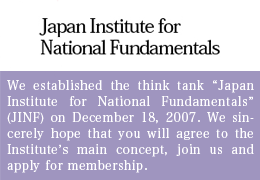ARBITRARY AND UNSCIENTIFIC DECISIONS BY JAPANESE NUCLEAR REGULATORY AUTHORITY RAISE SERIOUS QUESTIONS ABOUT ITS CREDIBILITY
On April 6, former Prime Minister Yasuo Fukuda urged Japan to join the China-led Asian Infrastructure Investment Bank (AIIB), declaring: “As a developed nation, we have no reason to oppose the bank project. Our opposition could be seen as bullying developing nations.”
What does Mr. Fukuda really mean by Japan “bullying developing nations”? Over the years, Japan has supported developing nations through its extensive Official Development Aid (ODA) program. The most outstanding feature of Japan’s ODA has been its transfer of technologies and funds that reflect the wishes of recipient nations. Because Japan has committed itself to helping develop local human resources in particular, its aid program has been valued surprisingly highly everywhere around the globe.
On the contrary, China’s aid program has been pursued with Beijing usually providing funds, technologies, and manpower with its own objectives first in mind. As a result, the recipients have acquired brand-new buildings, bridges, and highways—but not the coveted technologies they need for their future development. Furthermore, most of the labor workers on these projects stay behind following completion of the project, building bustling Chinese communities that create friction with the local communities.
That is why China has constantly been criticized for extending foreign aid just to meet its own national interests. In this vein, it actually is not Japan, but China, that is a “bully” to developing nations.
Can this situation be changed with the advent of the AIIB? At a time when the answer is still unclear, wasn’t Mr. Fukuda in effect representing China’s views when he made his comments about Japan being a bully to developing nations if it refuses to join the AIIB? Should Japan have enough financial resources to invest in the AIIB, I strongly recommend that every effort be made to improve the performance of the Asia Development Bank (ADB), which Japan has led since its inception in 1966. Borrowers would greatly welcome multiple international financial institutions, including the ADB and the AIIB, competing with each other to provide funds.
More concerning is what course the Japanese economy will take in the years ahead. China’s foreign exchange reserves are estimated at a whopping US$4 trillion, constituting a powerful magnet attracting Britain and other European nations as founding members of the AIIB. Meanwhile, Japan’s foreign currency reserves stand at roughly a quarter of China’s (US$1.2 trillion), its international trade having steadily been in the red since operations at all its nuclear power plants were halted as a result of the March 2011 Fukushima disaster. Last year, Japan registered the largest single-year trade deficit in its history—US$107 billion.
Major Cause of Japan’s International Trade Deficit
So long as its trade balance continues to run into deficit, Tokyo can hardly consider enhancing the ADB or joining the AIIB. Without being able to strengthen the economy, the future of Japan’s foreign policy, national security, and position in international finances will remain seriously handicapped. A major cause of Japan’s trade deficit is the suspension in 2011 of all of its nuclear power plants, having since forced utilities to steadily increase fossil fuel imports. That being the case, we should endeavor to realize an early resumption of nuclear power generation in Japan, making every effort to ensure the maximum safety of operations.
Be that as it may, why hasn’t the process of restarting the nuclear power plants progressed more than it has? It can be said that the biggest reason lies in the arbitrary and unscientific posture of the Nuclear Regulatory Authority (NRA), which appears determined to decommission all the nuclear reactors in Japan. On March 25, the NRA approved a report by an experts’ investigation team declaring as potentially active a seismic fault in Fukui Prefecture, on which Unit 2 of Japan Atomic Power’s Tsuruga Nuclear Plant rests.
The way things stand now, Unit 2 at Tsuruga is destined to be decommissioned. Japan Atomic Power already decided in March to dismantle Unit 1 in light of its poor economic efficiency.
Meanwhile, the NRA has also approved a report by an experts’ panel that “an active fault exists” directly below Higashidori Nuclear Power Plant run by Tohoku Electric in Aomori Prefecture.
But the method of the panel’s investigations and its conclusions have attracted many questions and much criticism. As one expert points out, the panel’s evaluation “is questionable from a scientific perspective.” For instance, in meetings to determine whether or not the fault underneath Tsuruga Nuclear Power Plant is active, the NRA allegedly kept turning down documents Japan Atomic Power had prepared as proof that the fault is indeed inactive. The NRA did not give a fair hearing to Japan Atomic Power, according to the expert.
Japan Atomic Power reportedly was hardly given a chance to state its case; even if it was, its presentations were cut off prematurely. The NRA failed to reply at all to a questionnaire submitted by Japan Atomic Power pointing out that the panel’s report contained a total of 63 errors. On top of this, it drew an arbitrary conclusion, determining the fault was active.
Not willing to bend an ear to the opinions of the utilities, the NRA is in the process of forcing utilities to decommission their aging nuclear reactors, declaring many of the faults underneath nuclear power plants to be active. Why on earth does the NRA reject scientific findings? Why doesn’t the Abe administration attempt to prevent the NRA from making arbitrary decisions?
Professor Tadashi Narabayashi of Hokkaido University points out an intriguing fact hardly noticeable under normal circumstances unless one is particularly attentive. As the wild argument gains strength that a fault under the ground of any nuclear power plant should lead immediately to its decommissioning, the NRA has implemented a revision of its regulations, intending to steer in the wrong direction the whole discussion about the safety of nuclear plants, deliberately lumping together entirely harmless faults and active faults. Explains Prof. Narabayashi:
“I’m referring to the new NRA rule enacted on July 8, 2013. Article 3 of the regulations stipulates: ‘In order to ensure safety against earthquakes, facilities must be constructed on a solid foundation devoid of any possibility of displacement.’ An accompanying clause explains that a ‘displacement’ refers to ‘a crack in the foundation created by the activities of faults that could become active.’ In this explanation, the NRA cleverly refers to ‘faults that could become active,’ rather than to “active faults.” The revised rule also states that facilities ‘must only be built on foundations in which faults that could become active in the future are not exposed to the surface.’ In other words, I think the new rule has made it much easier for the NRA to arbitrarily order any nuclear reactor decommissioned by regarding as potentially dangerous all types of faults across the board, not just the faults that are now judged as active.”
Negative Legacy of a Former Prime Minister
Prof. Narabayashi characterizes active faults as faults that trace their roots to “earthquake source faults,” stretching without interruption to the surface of the earth from depths of at least 3 to 5 kilometers underground, explaining:
“The activities of active faults result in various landslides and cracks in the ground, creating auxiliary faults or fractured zones. It can be said that the NRA has managed to encourage the unscientific view among the general public that all types of faults, including such cracks, are dangerous to nuclear power plants. What is absolutely important in ensuring the safety of nuclear power generation is to technologically evaluate how faults or fractured zones accompanying the activities of active fault will affect a plant’s facilities, and work out thorough protective measures. Discussing real active faults and other faults without making a sharp distinction among them does not contribute in any way to enhancing the safety of nuclear power plants.”
But why was the crafty change in the NRA regulations made, quietly altering “active faults” to “faults that could become active”? Prof. Narabayashi surmises that it is because of a negative legacy left behind by former Democratic Prime Minister Naoto Kan (September 2009-September 2011), who mishandled the Fukushima disaster and was avidly opposed to nuclear power generation.
In the April 30, 2013 edition of the Hokkaido Shimbun, the former prime minister said: “It’s highly unlikely that Japan will be able to afford to restart as many as 10 or 20 nuclear power stations in the future. The Democratic Party of Japan has firmly left behind a scheme, making it impossible for Japan to so readily resume nuclear power generation.” Kan said the establishment of the NRA was emblematic of his party’s overall energy policy, adding: “We have pointed out the existence of active faults underneath nuclear power plants across the nation, including Japan Atomic Energy’s Tsuruga Nuclear Power Plant (in Fukui Prefecture).”
What is actually happening to Japanese nuclear power plants today is in fact Kan’s prediction come true. From every point of view, the NRA’s conduct is unfair and unscientific. Its bias for the anti-nuclear power movement and repeated arbitrary judgments concerning active faults indicate that its members have indeed inherited Kan’s grudge against nuclear power.
The NRA is a highly independent extra-ministerial body made up of nuclear experts, attached to the cabinet office. Granted that intervening in its business would be politically difficult, but I believe Prime Minister Shinzo Abe as the chief administrator of the state should exert enough influence to consolidate its functions as the reliable regulatory body it was intended to be. (End)
(Translated from “Renaissance Japan” column no. 651 in the April 16, 2015 issue of The Weekly Shincho)








